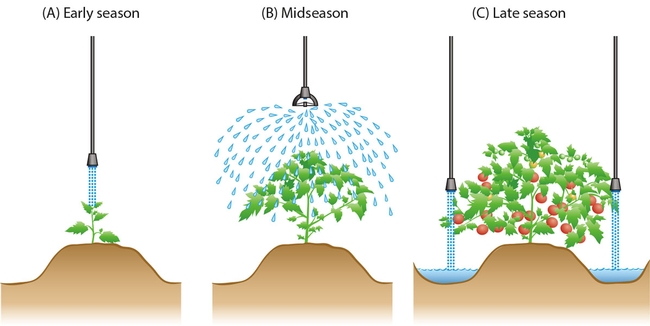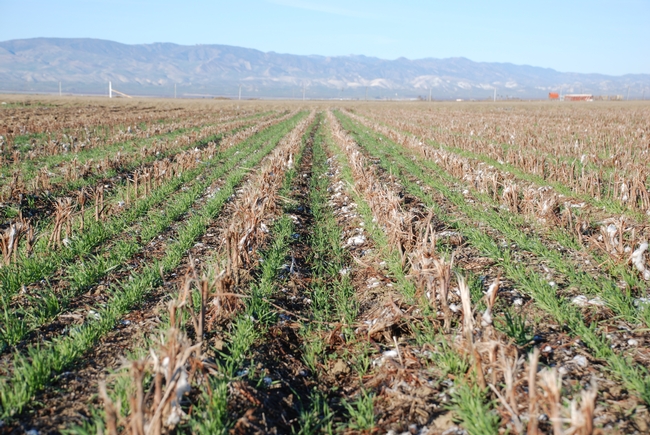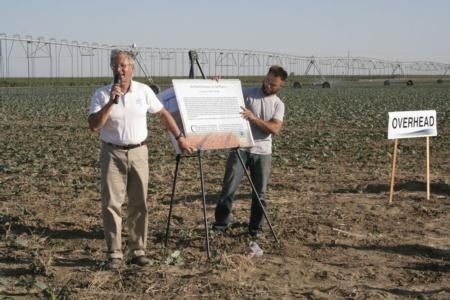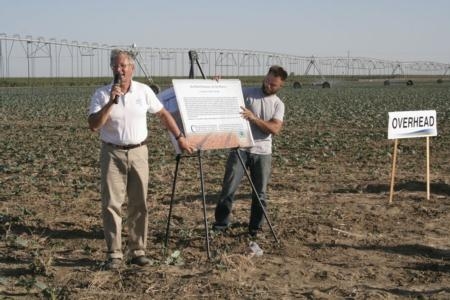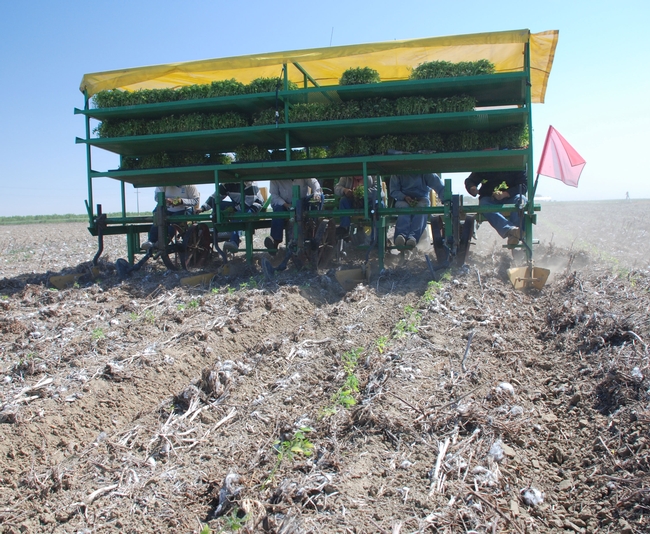Posts Tagged: conservation agriculture
Overhead irrigation holds water-saving potential for California farms
In California, 40 percent of agriculture is still irrigated by pouring water onto farmland, a much less efficient practice that drip and overhead irrigation. But those numbers are changing, reported Matt Weiser on Water Deeply.
Weiser interviewed UC Cooperative Extension cropping systems specialist Jeff Mitchell about the water-saving potential of using overhead irrigation, a system that is popular in other parts of the nation and world, but only used on 2 percent of California farmland. Mitchell was the primary author of a research article in the current issue of California Agriculture journal, which said that water and money can be saved using overhead irrigation in production of wheat, corn, cotton, onion and broccoli.
Mitchell said California researchers are looking more closely at overhead irrigation because they anticipate future constraints on agriculture, including water and labor shortages. Additionally, the system is ideal for combining with conservation agriculture systems, which include the use of cover crops, leaving crop residue on the soil surface and reducing tillage disturbance of the soil. The combination of overhead irrigation and conservation agriculture practices reduces water use, cuts back on dust emissions, increases yield and improves the soil.
Weisner asked how overhead irrigation could be as efficient as drip, when people typically see "water spraying everywhere from these roving sprinklers high off the ground."
Mitchell said farmers use pressure regulators and a variety of nozzles on hoses hanging down from the system to deliver water at precisely the rate and location where it is needed through the season.
"So, they're not spraying water. These are low to the ground, and there are various delivery nozzle practices that can be used," Mitchell said.
No-till agriculture has substantial benefits for Central Valley residents
Despite the many benefits of no-till agriculture - including water conservation, improved soil health and reduced dust - the concept is still a "hard sell" in California, reported Ken James in Comstock's Magazine.
The article featured a number of California farmers who sang the praises of the no-till farming method.
- "We definitely save money through higher production, less water usage and lowered equipment and fuel costs," said Modesto farmer Jesse Sanchez
- "We started in 1985 using the no-till method, and since then we've doubled our yield potential," said Fritz Durst, a Yolo County farmer
- "I not only get great production, I save a great deal by not buying expensive tilling equipment, and I look to double my production in times of little rainfall because no-till increases the water-storing capacity of the soil," said Michael Crowley, a Turlock farmer
UC Agriculture and Natural Resources (UC ANR) conservation agriculture expert Jeff Mitchell said the slow implementation of no-till in California is "largely a matter of our farmers not being familiar with no-till practices."
Tillage became popular in California in the 1930s. The agricultural systems developed in the state were wildly successful.
"Because they worked so well, and were so profitable, nobody has felt they should make a change," said Mitchell, who is a UC ANR Cooperative Extension specialist based at the UC Kearney Agricultural Research and Extension Center.
Mitchell is chair of the Conservation Agriculture Systems Innovation Center, a group of farmers, researchers, USDA scientists and ag industry professionals who are working together to spread the word about and encourage adoption of no-till production. Key CASI messages were shared in the Comstock article.
“Since water does not evaporate as quickly in no-till fields, savings in water cost are easy to determine,” Mitchell said. “In addition, fewer pesticides are often needed and farmers also save money by the diminished need to buy the expensive tilling equipment and to pay people to run them.” He adds that soil in the fields, no longer exposed by the tilling, remains richer in its biodiversity and can sustain higher yields. Compaction of the soils, caused by the heavy tilling equipment, is reduced.
San Joaquin Valley row crop growers help control greenhouse gases
Taylor interviewed lead researcher Jeff Mitchell, UC ANR Cooperative Extension specialist and chair of the UC ANR Conservation Agriculture Systems Innovation Center.
Long-term research by UC ANR has documented the capacity for farmland in the San Joaquin Valley managed with certain conservation practices to sequester carbon, results that could give farmers a seat at the carbon trading table, the article said. The study was published this month in the Agronomy Journal.
"We're reducing the atmospheric load of carbon dioxide, a greenhouse gas that plays an important role in global warming," Mitchell said. "Proving a stable storage location for carbon could allow agriculture to be part of future cap-and-trade programs."
The ANR news release on the research was also picked up by the Central Valley Business Times, California Political Review and the Red Bluff Daily News.
Click here to listen to Doug Cooper of AgLife radio interview Mitchell about the research.
UC conservation ag specialist is no-till farming's 'Johnny Appleseed'
The untiring leader of the UC Conservation Agriculture Systems Innovation Center, Jeff Mitchell, was compared to the legendary American farming pioneer Johnny Appleseed by the author of The Grist's Thought for Food blog, Nathanael Johnson.
Mitchell, UC Cooperative Extension specialist in the Department of Plant Sciences at UC Davis, took Johnson to research fields and farms to show progress being made toward more sustainable production practices in California row-crop farming. Johnson turned the visit into a 1,300-word feature that included links to conservation agriculture research Mitchell has published in California Agriculture journal.
"There's a soil scientist at Berkeley, Garrison Sposito, who says it may be just once or twice in a century that agriculture has an opportunity to re-create itself in a revolutionary way," Mitchell said. "... I think that's what's happening with conservation agriculture. It's energizing for me to wake up to that every day.”
Mitchell and his colleagues are proponents of four tenants of conservation farming:
- Don't disturb the soil
- Maximize the diversity of plants, insects, fungi and microbiota
- Keep living roots in the soil
- Keep the ground covered with plant residues
Mitchell took the writer to the UC West Side Research and Extension Center in Five Points to see research plots that have been farmed continuously with conservation techniques. The beds "have not been worked in 15 years," Mitchell said. “There's more organic material going into the soil, more carbon and more nitrogen. There's more capture of water, and the shade and residue reduces soil water evaporation.”
As the years passed, the soil improved. Instead of the farm equipment needing to break up clots of compacted soil, the researchers found they were planting into soft, fine-grained earth, continuously tilled by worms and roots and microorganisms.
Mitchell learned that residues and no-till practices can reduce irrigation water needs by 16 percent, as well as cut down dust emissions and store extra carbon in the soil.
'Thought for food' chews on conservation agriculture
Blogger Nathanael Johnson, who writes 'Thought for food' on the Grist website, recently contemplated the impacts of reduced soil tillage on the use of chemical herbicides and crops genetically engineered to tolerate herbicide applications.
He noted that the practice of tillage in farming does not mimic nature.
"Nature only rarely turns the land upside down — only during disasters," Johnson wrote. "This ecosystem (soil) responds to being turned upside-down the same way a rainforest would: It falls apart."
However, the author wondered whether the development of herbicide-tolerant crops has led farmers to adopt conservation tillage. For an answer, he turned to Jeff Mitchell, UC Cooperative Extension specialist in the Department of Plant Sciences at UC Davis.
“I’ve heard farmers here in California say that Roundup resistant crops effectively allowed some people to start doing conservation tillage,” Mitchell said. “But you have to remember, the vast majority of farmers in the U.S. using Roundup Ready seed don’t do conservation tillage.”
Garrison Sposito, professor in the Department of Environmental Science, Policy and Management at UC Berkeley, said genetically modified crops and herbicide use aren't required for conservation agriculture, but without them, yields go down.
"You never solve problems by making changes,” Sposito said. “What you do by making changes is exchange one set of problems for another set of problems.”
Have GMOs triggered conservation-minded agriculture? In the U.S., just a little bit, Johnson concluded.

